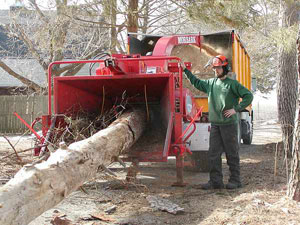Arborist
Tasks & duties

Arborists may do some or all of the following:
-
consult with the public and/or clients regarding tree maintenance and/or removal
-
identify, inspect and maintain trees
-
prune, plant and transplant trees
-
landscape areas
-
remove trees, including dangerous or inappropriately planted trees, by felling or sectional felling
-
monitor and trim trees near power and telephone lines
-
clear fallen and damaged trees after storm damage
-
remove stumps
-
identify potential tree hazards and work to minimise these risks
-
plan pest management and spray to control pests
-
maintain equipment
-
mediate between local authorities and members of the public about resource management
-
represent clients in property damage cases
-
operate a plant or tree nursery
-
run their own business
Specialisations
Arborists may specialise in a number of areas including council work (municipal arborists), power line work (utility arborists), and training or consulting.
Experienced arborists may become team leaders or managers.
Skills & knowledge

Arborists need to have:
-
knowledge of horticulture including plant and soil biology and tree species identification
-
landscaping skills
-
skill in planting and pruning
-
understanding of arboricultural practices such as tree climbing
-
knowledge of safe work practices, including how to use chainsaws safely
-
knowledge of pest control
-
an understanding of environmental management
-
first aid skills
-
good planning and organisational skills
-
communication skills
Entry requirements
There are two main ways to qualify as an arborist in New Zealand:
Learning on the job
You can learn on the job by completing the national certificate as an apprentice or as a workplace trainee through the Horticulture Industry Training Organisation, or Telford Rural Polytechnic.
Not all workplaces offer apprenticeships or work place training.
Full-time study
Full-time arboriculture courses are offered at Wintec (Waikato Institute of Technology) and Otago Polytechnic.
Secondary education
At least three years of secondary education is recommended. Useful subjects include horticulture, biology, English and maths.
Training on the job
After at least three years' experience, arborists may also apply to become an ISA (International Society of Arboriculture) Certified Arborist. This involves passing an initial exam and then doing a specified amount of training each year. The ISA Certified Arborist qualification is internationally recognised, and useful for arborists who wish to travel outside New Zealand.
New Zealand Arboricultural Association website – information on ISA Certification
Registration
There is no official registration scheme for arborists but the New Zealand Arboricultural Association (NZAA) is working on a code of practice that specifies what skills someone must have before they can call themselves an arborist.
The Approved Contractor scheme run by the NZAA sets standards and criteria for firms.
Useful experience
Any horticulture or gardening experience, such as plant maintenance or pruning, is useful for arborists.
Related courses
Crop Production
Horticulture
Land, Parks and Wildlife Management
Landscape Architecture
For more information, please refer to Career Services.
Document Actions
